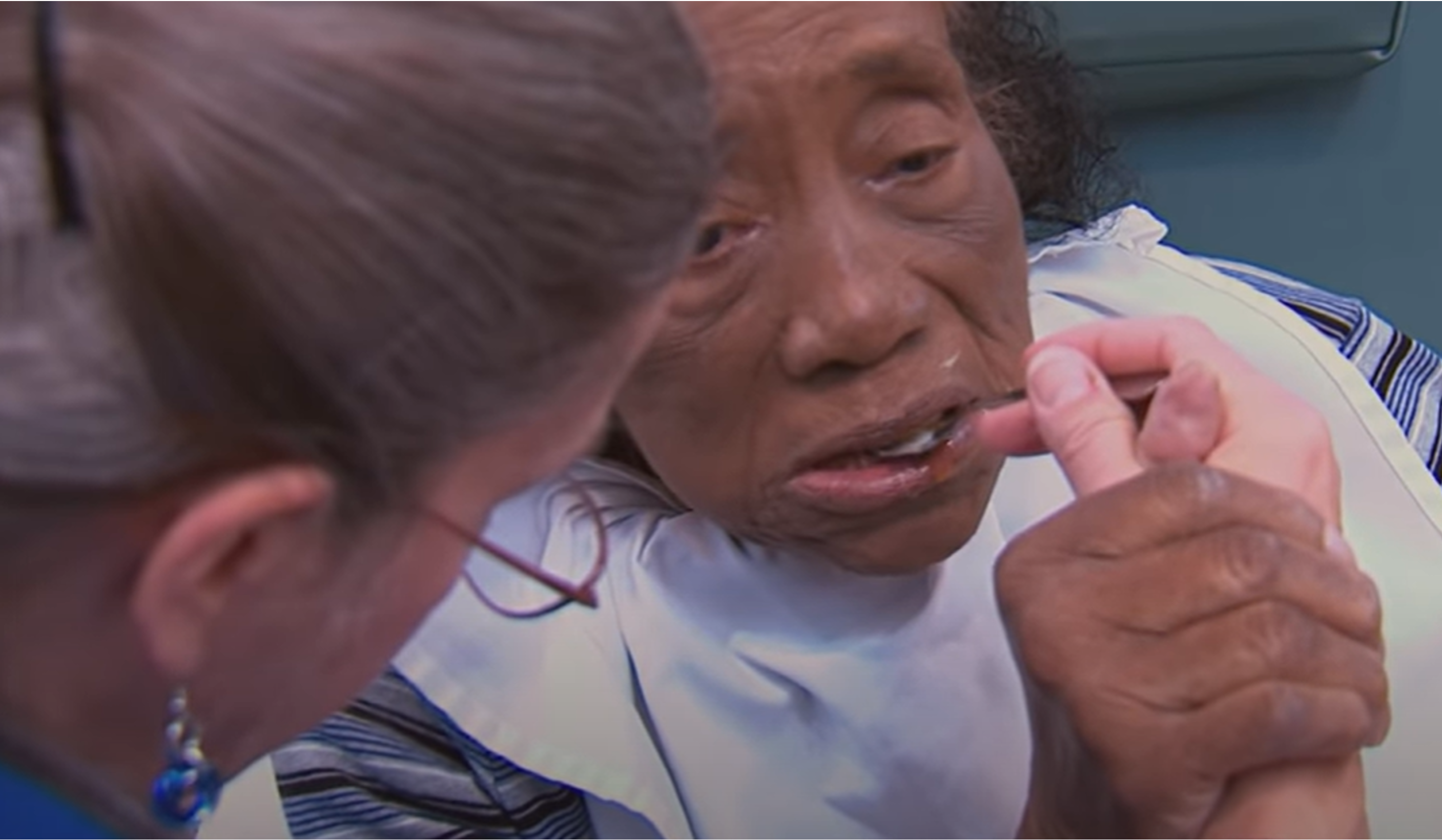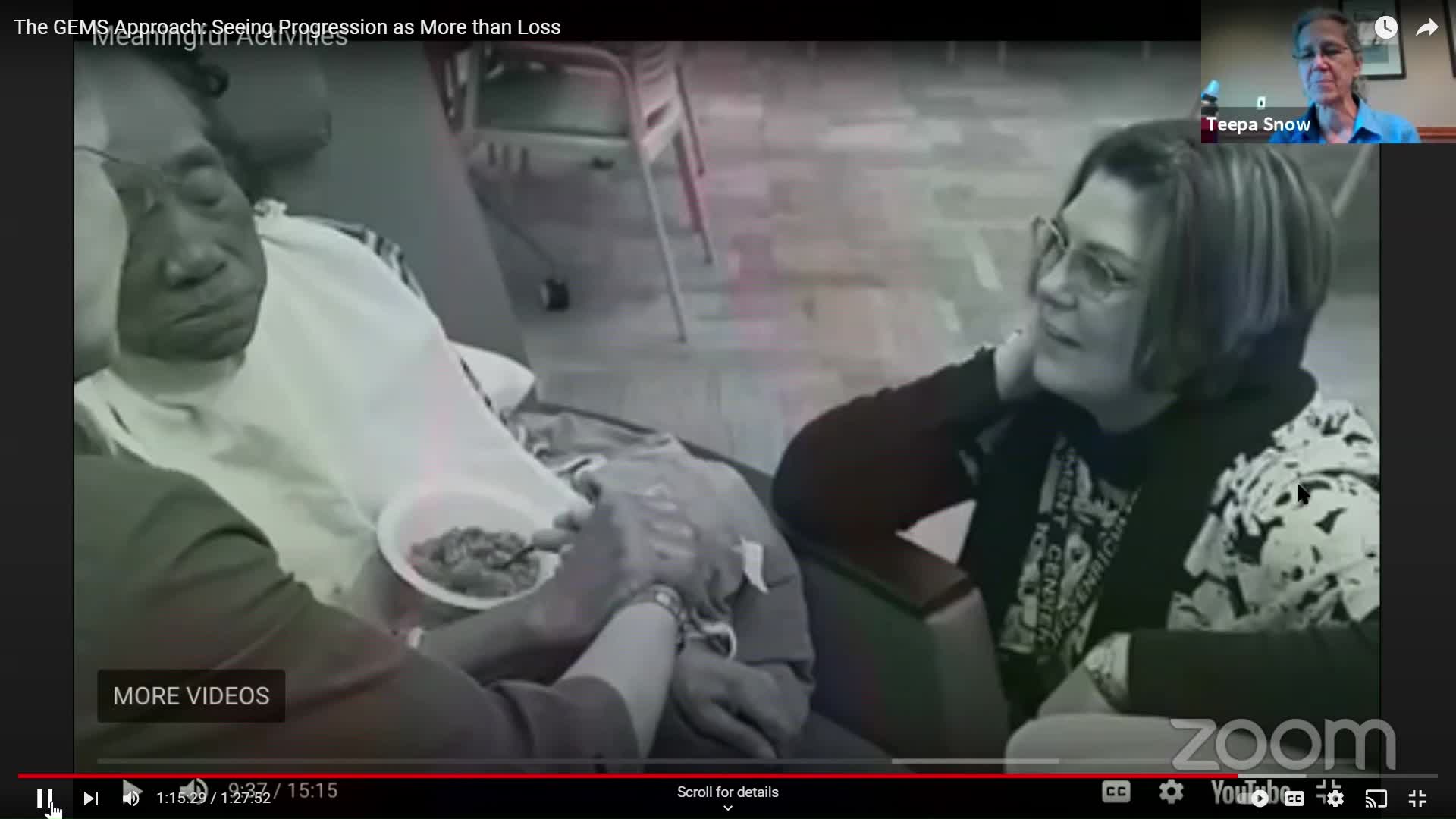Editor's note: This text-based course is a transcript of the webinar, Dining Well With Dementia: This Is A Lot To Swallow!, presented by Laurie Walther, MS, CCC-SLP.
*Please also use the handout with this text course to supplement the material.
Learning Outcomes
- After this course, participants will be able to differentiate patterns of feeding, eating, and swallowing in typical vs. atypical aging.
- After this course, participants will be able to identify 4 progressive brain changes related to dementia that impact the feeding, eating, and swallowing process.
- After this course, participants will be able to examine the effectiveness and rationale for 4 strategies for safe and effective feeding, eating, and swallowing throughout the progression of dementia.
Introduction
I'm thrilled to be back in this session. I have another course in the library that touches on some of these topics (Course #6144). For those of you joining me for the first time, I’m equally excited to have you here. There’s a lot of ground to cover quickly, so I appreciate your patience as we work through it together.
Some of the content might feel familiar if you’ve attended my previous presentation, but this time, we’ll explore those key points through the lens of how the disease process progresses concerning eating and dementia.
Let’s briefly talk about the impact of dementia. Over time, dementia changes everything. It’s not something a person can control, and it manifests differently for everyone. It’s important to recognize that dementia is not a mental illness. It’s real, it’s challenging, and it affects not only the person living with dementia but also their care partners.
Progressive brain changes are central to this process. A person with dementia might be capable of certain actions one moment and unable the next. These abilities can ebb and flow, and as care partners, we must stay attuned to these shifts and adjust our responses accordingly. Our role is to support the person in doing what they can and to participate with them rather than doing things for them. You’ll notice the term "PLwD" throughout the presentation—this stands for "person living with dementia." While it’s helpful shorthand here, it’s important to note that it’s not an approved Medicare or insurance documentation abbreviation.
It’s also critical to clarify that dementia does not equal Alzheimer’s, nor does it equate solely to memory problems. Dementia encompasses over 120 types, with Alzheimer’s being just one of them. While memory challenges are often associated with dementia, many other symptoms and complexities can arise depending on the specific type.
Now, I’d like you to take a moment for self-reflection. How would you rate your understanding and knowledge of dementia? What about your knowledge of the relationship between eating and dementia?
With that, let’s get started and begin learning together.
Typical vs. Atypical Aging
Let's start by exploring typical versus atypical aging related to eating and drinking. In typical aging, individuals generally retain the ability to feed themselves, follow established mealtime routines, and make choices about their meals. They often maintain a good appetite, which helps ensure adequate nutrition and hydration. The social environment supports and reinforces their eating behaviors, and their swallow function remains intact.
In contrast, atypical aging introduces challenges. Individuals may lose the ability to feed themselves and struggle to recall the sequential steps involved in eating—a process that, if broken down, involves over 75 distinct steps. These difficulties can lead to reduced intake, compounded by an inability to communicate wants and needs effectively. Additionally, social environments may become overwhelming, further decreasing intake. Swallow function may also begin to decline, adding another layer of complexity.
When discussing typical versus atypical aging in the context of dementia, we need to address aversive feeding behaviors. These can include refusing to eat, spitting out food, refusing to swallow, holding food in the mouth, or turning away from food. Unfortunately, these behaviors are often misinterpreted as resistance rather than a disease symptom, leading caregivers or staff to cease feeding attempts. This misunderstanding significantly increases the risks of dehydration, malnutrition, and mortality.
Current practices reveal a concerning gap: despite existing evidence and clinical guidelines for supportive feeding, many caregivers and healthcare workers remain untrained and unprepared to handle mealtime difficulties in persons living with dementia. This lack of preparation highlights the need for thorough training—something we, as professionals, should be leading.
Various factors can cause changes in eating behavior due to dementia. Physiologically, individuals might develop a delayed swallow reflex or lose the ability to use utensils. Psychologically, they may experience a loss of appetite or memory-related challenges. For example, the hypothalamus, which regulates hunger and thirst, may not function properly, resulting in decreased intake. Social and environmental factors can also play a role, while behavioral changes may manifest as eating too quickly, eating too slowly, or not eating at all.
Certain types of dementia have unique clinical features that impact eating behaviors. For example, in frontotemporal dementia, changes in dietary preferences are a key diagnostic feature. Meanwhile, weight loss is a hallmark of Alzheimer’s disease. Alzheimer's patients may forget to eat, lose their appetite, or repeatedly eat throughout the day, thinking they haven’t already eaten. Compounding this, a heightened loss of smell—common in healthy aging—is even more pronounced in Alzheimer’s, further diminishing the sensory experience of eating.
Frontotemporal dementia, which primarily affects the frontal and temporal lobes, is one of the most common forms of early-onset dementia. Profound changes in personality, social functioning, and dietary habits often mark it. Over 60% of individuals with frontotemporal dementia exhibit hyperorality and dietary changes at the time of diagnosis. Alongside cognitive, behavioral, and functional deficits, these symptoms can lead to increased depression, isolation, and loneliness—all of which are risk factors for malnutrition.
As we assess eating behaviors, we must consider normal age-related changes and disease-driven ones. Modifications to support individuals with dementia must address multiple dimensions, including food choices, eating habits, and dietary intake. For example, behavioral factors influencing intake may occur before food enters the mouth while eating habits pertain to the act of consumption itself. On the other hand, dietary intake focuses on consumed food's quantity and nutritional value.
By understanding these complexities and tailoring interventions to individual needs, we can help mitigate the risks of malnutrition, dehydration, and diminished quality of life in persons living with dementia.
Progressive Brain Changes
Let’s explore the progressive brain changes associated with dementia, particularly concerning eating. Some of this might feel familiar if you've attended my other session. These concepts are critical to understanding how we support individuals as their condition progresses. Repetition reinforces these key ideas.
When we think about progressive changes, we must consider the sensory, cognitive, and motor aspects of the feeding process. Eating involves all five senses—vision, hearing, touch, smell, and taste. However, as dementia progresses, these senses can be impaired. Language is also affected, leading to difficulty understanding or communicating wants and needs. This impacts the ability to carry out basic self-care tasks like feeding. Sequencing, a skill often taken for granted, becomes a challenge. Feeding involves initiating the task, recognizing the sequence of steps, identifying objects, and completing the process. Cognition—recall, executive functioning, problem-solving, and attention—further complicates matters.
Communication changes profoundly. Imagine saying to someone, “Hey, Mr. Smith, here’s your lunch today. You have chicken, mashed potatoes, and green beans. Go ahead and start.” As cognitively intact individuals, we can process and act on this instruction. But for someone living with dementia, even in the earlier stages, up to a quarter of spoken words can be missed. As the disease progresses, they might only catch fragments of words or phrases, often out of context. Their responses might be based on rhythm, tone, or emotional cues rather than understanding.
I recall working in a memory support unit where staff repeatedly told a resident to “take a bite of your chicken.” After hearing this instruction over ten times, she turned to me and said, “Hey, sweetie, which one’s the chicken?” It was a stark reminder that even when words are heard, their meaning might not register. In these cases, a combination of verbal, visual, and tactile cues is vital to help bridge the gap.
Feeding and eating rely on a natural, connected sequence—hand to mouth to swallow. If any part of this sequence is disrupted, the process becomes disjointed. Our goal should always be to maximize independence in feeding for as long as possible. This might involve initiating feeding, using adaptive equipment like finger foods to bypass the need for utensils, or employing techniques like the Hand-under-Hand® approach. For example, I recall working with Miss Lucille. She felt in control of the process using the Hand-under-Hand® method, where her hand was guided but remained on top. This approach respects autonomy while providing necessary support.
Video Example 1

Picture Examples




Figures 1-4. Examples of the Hand-under-Hand® method.
As dementia progresses, motor skills also decline. Fine motor tasks like buttoning become difficult. Individuals may exhibit a strong grasp but reduced dexterity, often reverting to gross motor movements like those seen in early development stages. This is where the theory of retrogenesis comes into play—skills developed first in infancy are often the last to be lost. Over time, this leads to difficulty releasing objects and can result in contractures.
From a visual perspective, changes in the occipital lobe can significantly affect perception. Peripheral vision narrows, transitioning from binocular to monocular vision and eventually to a restricted field. This explains behaviors like reaching across the table for another’s plate—simply because the individual cannot see their own. Sensory input becomes overwhelming, leading to adaptations such as closing their eyes while eating to focus solely on chewing and swallowing, as seen in the next video.
Video 2

Taste and tactile changes further complicate eating. Many individuals with dementia lose sensitivity to sweet and salty flavors while retaining bitter and sour sensations. They often crave sweets, so adapting their diet to ensure adequate nutrition is essential. If adding sweeteners improves intake, it’s worth considering—even using alternatives for individuals with diabetes. Tactile issues, such as aversions to certain textures or temperatures, can also impact the desire to eat. This is why avoiding practices like mixing pureed foods into a single unappealing texture is critical.
Ultimately, understanding these changes helps us better support those with dementia. We can improve their quality of life by recognizing their preferences and adapting our approaches. For example, when you reflect on your eating habits—what you like, when you like it, and how you like it—consider how personal these preferences are. This understanding can extend beyond food to daily routines like bathing, dressing, and even choosing activities. Recognizing and respecting these preferences fosters dignity and improves outcomes in every aspect of care.
Adaptive Equipment, Techniques, Feeding Strategies
Let’s explore adaptive equipment, techniques, and feeding strategies, acknowledging that many of these tools and methods are already part of our daily practice. As therapists, whether we specialize in speech, occupational, or physical therapy, we often collaborate on recommendations. For example, a speech therapist might notice someone struggling to feed themselves and suggest adaptations to the occupational therapy practitioner. While collaboration is essential, we should also have a solid understanding of these strategies and be prepared to try them out when appropriate.
Numerous tools are available, such as weighted, curved, or built-up utensils, plate guards, finger foods, maroon spoons, and specialized cups. But sometimes, the solution can be as simple as thinking outside the box. For instance, consider serving one item at a time in a bowl with a single spoon instead of presenting an overwhelming array of food. By simplifying the environment, we often enable individuals to feed themselves more successfully.
Reflecting on feeding experiences, many of us have pet peeves about common practices that compromise dignity and effectiveness. Examples include caregivers feeding multiple people at once, feeding too quickly, or shoving food into someone’s mouth. There’s also the issue of poor positioning, such as feeding someone who is reclined or slouched in their chair, and practices like speed-feeding or using utensils to wipe someone’s mouth instead of a napkin. These behaviors create frustration and anxiety, not just for the caregiver but for the person being fed, who inevitably picks up on the tension.
One hard truth about feeding is that they often depend on assistance once we feed someone. While this is sometimes necessary, our goal should always be to maximize independence for as long as possible. Dependency on feeding increases the risk of aspiration pneumonia by up to 20 times compared to those who can feed themselves. Unfortunately, poorly trained caregivers often feel pressured to complete feeding tasks quickly, leading to practices like force-feeding or failing to recognize subtle signs of dysphagia, such as throat clearing or a slightly wet voice.
The solution lies in education. By equipping CNAs and other caregivers with the knowledge and skills to manage feeding challenges effectively, we empower them to feel confident and successful in their roles. This improves the quality of care and directly benefits the individuals we serve.
Regarding care strategies, our role is to be detectives, not judges. We must observe, listen, and think critically about what might be causing a behavior or feeding challenge. For example, if someone resists feeding, it might be because the food is unappealing, they’re uncomfortable, or they’re not ready to eat. Obtaining permission before providing care is crucial—it sets the tone for a respectful interaction. Pushing an agenda without considering the individual’s needs or mood often leads to resistance.
Cueing is another essential strategy, and it should follow a specific hierarchy: visual (show), verbal (tell), and tactile (touch). Matching our assistance to the person’s remaining abilities allows us to work with them, not do things to or for them. Techniques like the Hand-under-Hand® method are particularly effective, as they leverage procedural memory—one of the last cognitive functions to decline in dementia. By guiding the person’s hand while allowing them to feel in control, we tap into familiar patterns, such as using a utensil, to maximize function.
Feeding interventions should also consider the individual’s social and emotional needs. Promoting social connection during meals can enhance the experience, but adapting these interactions to the person’s preferences and tolerance is essential. Similarly, interventions should be trialed individually to assess their effectiveness without introducing multiple variables.
Throughout this process, it’s vital to remember the fluidity of dementia. What works one day or one meal may not work the next, requiring us to adapt our approach continually. Every decision should be guided by understanding the "why" behind a behavior or challenge, aligning interventions with goals, and documenting them effectively.
Ultimately, the heart of dementia care lies in relationships and interactions. It’s not just about what we do or say but how we make the person feel. As dementia progresses, we must focus on preserving what abilities remain, finding new ways to engage, and always treating the individual with respect and empathy.
Change in Status
When you notice a change in status, it’s time to grab those detective hats again and figure out what’s going on. A quick assessment might reveal a simple fix or point to a deeper health issue. For example, sudden changes could be due to a urinary tract infection (UTI), pain, discomfort, or problems with dentures or oral health. Medication changes or interactions could also be contributing factors, or it might simply be the natural progression of dementia.
Let’s talk about polypharmacy. It used to be defined as nine or more medications, but in geriatrics, the threshold is now five to six. This means most of our older patients likely fall into this category. Polypharmacy isn’t just about the number of medications; it’s about their combined effects. In dementia patients, we must be especially mindful of antipsychotics. While these medications might be prescribed for behaviors labeled as "problematic," they can have significant side effects, including extrapyramidal symptoms. These symptoms can lead to movement dysfunction, tremors, and dysphagia, as well as esophageal dysmotility, which complicates feeding and swallowing.
This is why it’s so important to reframe “behavior.” Most of the time, behaviors are a form of communication. Before reaching for medications, we must ask ourselves what the person is trying to express. If we medicate without understanding, we risk exacerbating the challenges they already face. Imagine living with dementia and then adding swallowing difficulties or motor dysfunction—this compounds an already complex situation.
When a quick assessment doesn’t uncover the issue, it’s time to dig deeper. There are many potential changes to consider. It could be as straightforward as ensuring pre- and post-meal hygiene or establishing consistent bathroom habits. Environmental distractions, sensory changes, and advancing dementia can also play a role. Remember, the little details matter; sometimes, small adjustments can make a big difference.
As we work to support individuals living with dementia, we must also recognize that care is a partnership—it takes "two to tango." This means we have a choice in approaching situations: Will we collaborate and adapt or be tangled in frustration? By staying curious and focused on understanding the "why" behind a change, we can position ourselves on the side of collaboration, providing the most compassionate and effective care possible.
Dehydration and Malnutrition
Dehydration is a critical issue with significant physiological impacts. It can lead to loss of strength and stamina, fatigue, and confusion. Dehydration exacerbates mobility challenges, increasing dizziness, fall risk, and even muscle cramps. It reduces urination frequency, often producing dark-colored urine, and frequently leads to UTIs. Additionally, a dry mouth makes it harder to eat or drink, compounding the problem. The effects are cumulative, creating a cycle that is difficult to break.
One of the key causes of dehydration is the lack of thirst. The hypothalamus may no longer signal the need to drink, or the individual might lack the skills or awareness to hydrate independently. Limited opportunities to drink and reliance on others for fluids also contribute. Medications can further complicate matters, and the fear of incontinence often discourages individuals from drinking. The monotony of available liquids or an aversion to thickened liquids can also play a role. Thickened liquids, in particular, are not inherently dehydrating, but many people dislike them, reducing their overall intake.
Addressing dehydration requires creativity and a personalized approach. Ideas include offering decaffeinated drinks to reduce urination frequency, providing visually appealing options like colorful beverages, and incorporating hydration into enjoyable items such as soups, Jello, or ice cream. Adding variety can make hydration more appealing, whether through carbonation, flavored powders, or beverages with calories for added nutritional benefit. The goal is to make drinking as engaging and accessible as possible while considering protocols like the Frazier Free Water Protocol (FFWP). It is a speech pathology intervention that allows patients with dysphagia to drink water between meals where appropriate.
Malnutrition is another significant concern with a wide-ranging impact. Physiologically, it weakens muscles, reduces energy, and impairs the immune system. Socially, malnutrition can lead to isolation and depression, while cognitively, it diminishes awareness of the need to eat. Poor oral health and ill-fitting dentures can add to the challenges, as can prolonged hospital stays or surgeries that complicate recovery. Reduced muscle mass and overall strength often increase the risk of falls, perpetuating a dangerous cycle.
Medical conditions, mental health issues like depression, dental problems, and a diminished hunger drive linked to hypothalamic changes are causes of malnutrition. Feeding skills might be impaired, there might be limited opportunities for snacks and meals, and medications could suppress appetite. Sensory changes, such as altered taste and texture preferences, can further reduce intake.
Strategies to combat malnutrition should be flexible and tailored. Offering familiar and new foods, frequent snacks, and supplements with physician approval are helpful approaches. A controversial but effective strategy is to abandon rigid dietary restrictions to maximize intake and preserve dignity. If someone enjoys eating the same meal repeatedly, let them. Focus on ensuring they eat rather than adhering to arbitrary rules about variety.
Significant weight loss, defined as a 5% reduction in body weight within 30 days or 10% over six months, is a red flag. However, we should act before reaching these thresholds. If a good eater begins to push food around their plate or consume less, we should intervene promptly. Waiting for a trend wastes precious time and risks serious consequences.
Measuring intake and understanding mealtime behaviors require attention to detail. Percentages of food consumed can be misleading and inconsistent. A better approach might include weighing meal trays before and after or monitoring body weight over time. Feeding is time-intensive and should involve a reciprocal, respectful relationship, not a rushed, mechanistic process. Meals should take at least 30 minutes for adequate intake, enjoyment, and digestion.
Unpleasant mealtime experiences often deter individuals from eating. Loud environments, unappetizing or poorly prepared food and the lack of choice can all discourage intake. Reflect on your own experiences—if a meal was unenjoyable, would you want to eat more? Creating pleasant, dignified mealtime environments is essential for promoting health, quality of life, and dignity among those we serve.
Additional Strategies
Let’s explore strategies to support individuals with dementia through curative, preventative, and adaptive approaches. These tools enhance the feeding experience and promote dignity, independence, and well-being.
Adaptive equipment can be a game-changer. Modifying utensils, using contrasting colors for place settings, and introducing finger foods are straightforward yet effective techniques. For instance, studies show that high-contrast plates can increase food intake by 15%. Optimal positioning is equally critical—improper posture can set a person up to fail before they’ve even begun to eat. Collaboration with other rehab professionals ensures safe and effective positioning, especially when techniques like head turns or tilts are needed.
Color also plays a fascinating role in stimulating appetite and managing intake. Red plates, for example, can enhance appetite by making food stand out, while dark blue settings may suppress it, helping manage overeating. Lime green is an attention-grabbing color that can be used to highlight key objects or utensils. Conversely, black can pose challenges for individuals with dementia, as it may appear like a hole, creating confusion. Thoughtful color choices in tableware and dining environments can have a surprising impact.
Comfort strategies extend beyond the physical. Proper incontinence care before meals is essential—no one feels like eating if they’re uncomfortable. Addressing bowel regularity is another often-overlooked factor. Digestion is one continuous process; discomfort in one area will inevitably impact another. Understanding individual preferences, such as coffee before breakfast or specific meal routines, personalizes the experience and makes it more enjoyable.
The environment plays a crucial role. Distractions can halt the feeding process, whether it’s a caregiver asking a question mid-meal or loud conversations in the dining area. TVs in dining rooms are particularly problematic; they distract and encourage poor head posture, increasing the risk of aspiration. On the other hand, music, when selected thoughtfully, can be transformative. Studies show it can reduce physical agitation, restlessness, and aggression while increasing caloric intake by up to 20%.
Medical and sensory strategies include waking up the senses before meals with a touch of carbonation or ice chips. Familiarity with food and creating a “fine dining” experience can also make a significant difference. Offering choices—and respecting changes if someone doesn’t like their initial selection—supports autonomy. Supplements can be creatively incorporated into puddings or even coffee and tea to sneak in extra nutrients.
An interdisciplinary team approach is indispensable. Collaboration among physicians, dietitians, dentists, and other professionals ensures holistic care. Staying active and keeping individuals engaged in their care, even in end-stage dementia, respects their beliefs, desires, and cultural preferences.
Creativity and curiosity are vital when addressing challenges. For example, while it’s true that alertness is necessary for safe feeding, alertness isn’t defined solely by open eyes. A closed-eye response might simply mean the individual is savoring the moment, not that they’re disengaged. Training should move beyond rigid, black-and-white rules to embrace flexible, person-centered practices.
Ultimately, success lies in adapting to the individual. By observing, experimenting, and putting the puzzle pieces together, we create tailored approaches that respect their dignity and individuality. Feeding isn’t just a task—it’s a deeply human experience that connects us all. Let’s learn, apply, and stay ready to make each mealtime meaningful and supportive for those in our care. Here is our last video example.
Video 3

Summary: Learn, Apply, and Be Ready!
As I’ve emphasized throughout, the key is to learn, apply, and be ready. This approach allows us to adapt thoughtfully and effectively to the needs of individuals living with dementia.
Take a moment now to reflect. Think about a current or recent person living with dementia whom you’ve supported. Consider two changes you could make based on the insights you’ve gained today. Don’t hold back. Be creative, be bold, and remember that change starts with us.
Ultimately, it is our role to facilitate these changes. The person living with dementia cannot adapt to their environment or circumstances on their own, so it is our responsibility to meet them where they are and make the necessary adjustments.
Questions and Answers
What have you found to be most effective in addressing persistent challenges, such as CNAs being overloaded with feeding responsibilities?
This is a tricky and long-standing issue, and I agree—it seems it’s been around forever. From my experience, I’ve found that one-on-one education followed by return demonstrations works well. Watching a video or attending a general training is one thing, but hands-on practice tends to stick. When I train care partners, I emphasize the importance of empowering them and providing positive reinforcement. They’ll often say, “I’ve seen this before,” but then they walk away with a new insight and thank us for the practical takeaways.
At a nursing home I worked with in Florida, we implemented a volunteer feeding program. Volunteers couldn’t just jump in; they had to undergo training and competency check-offs with me before being paired with specific residents. This eased the CNAs’ burden and ensured that feeding assistance was safe and respectful.
Do you interact with administrators to advocate for changes in CNA productivity expectations?
It’s a delicate balance, navigating these discussions with administrators. My approach has always been to focus on the residents and frame suggestions around their quality of care. While we can’t always shift administrative priorities overnight, emphasizing how empowering CNAs and reducing turnover ultimately benefits the residents can resonate. I’ve also learned to pick battles wisely and focus on collaboration, ensuring that any proposed changes are practical and aligned with broader facility goals.
Can you provide an example of asking a CNA for a return demonstration?
Absolutely. For instance, after demonstrating a feeding strategy, I’ll ask the CNA to take over during the same or the next meal. I’ll confirm their availability and meet them at that specific time. This collaborative approach gives them a sense of control over their schedule, and I observe them feeding the residents to ensure they’re applying what they’ve learned correctly. While consistency can be a challenge, especially with high staff turnover, this hands-on method ensures they understand and can replicate the strategy when I’m not there.
How can you determine if a patient’s vision has declined to binocular or monocular stages?
It’s often difficult to assess directly, especially if the individual can’t communicate clearly. However, dining observations can provide clues. For example, if a resident is reaching for objects outside of their tray or struggling to locate utensils, try repositioning the items closer. If they suddenly manage better, it’s likely their visual field has narrowed. This aligns with common peripheral vision loss in dementia, even without a stroke diagnosis.
What are your thoughts on the increasing number of food texture levels, like those in the IDDSI framework?
While the International Dysphagia Diet Standardisation Initiative (IDDSI) framework provides more detailed guidelines, it can feel overly complex in certain settings, particularly in skilled nursing. Some facilities have resisted adopting it because it’s challenging to implement consistently. For me, the focus should always be on individual assessments. If someone is safe with regular mashed potatoes but struggles with oatmeal, I’ll write an order specifying that. It adds flexibility and provides residents with more choices, but it does create additional documentation challenges.
Can you share thoughts on alcohol consumption for individuals with dementia, like a resident who enjoys wine?
Alcohol consumption in dementia care requires a personalized approach. It’s crucial to consider medical factors, such as medication interactions and the individual’s history with alcohol. If alcohol is permitted, monitoring for safety is essential. In some cases, offering non-alcoholic alternatives might satisfy their craving for flavor or ritual without introducing additional risks. While some may view this as deceptive, it can be an effective compromise if it meets their sensory or social needs. Always consult with the care team and family to determine what’s appropriate.
Feel free to reach out with additional questions or requests for resources!
References
Please refer to the additional handout.
Citation
Hamlin-Pacheco, K. (2025). Dining well with dementia: This is a lot to swallow! OccupationalTherapy.com, Article 5772. Available at www.occupationaltherapy.com
